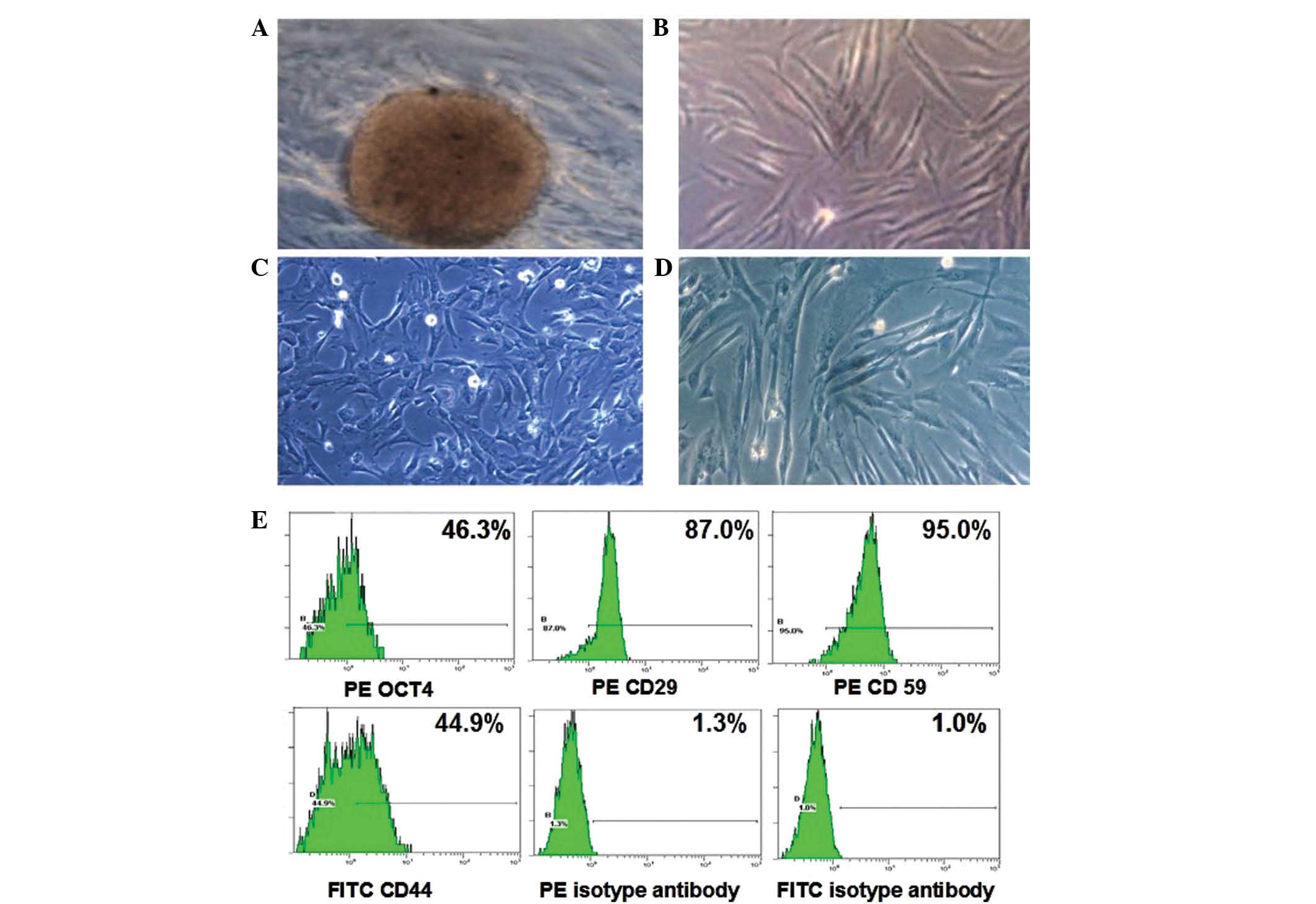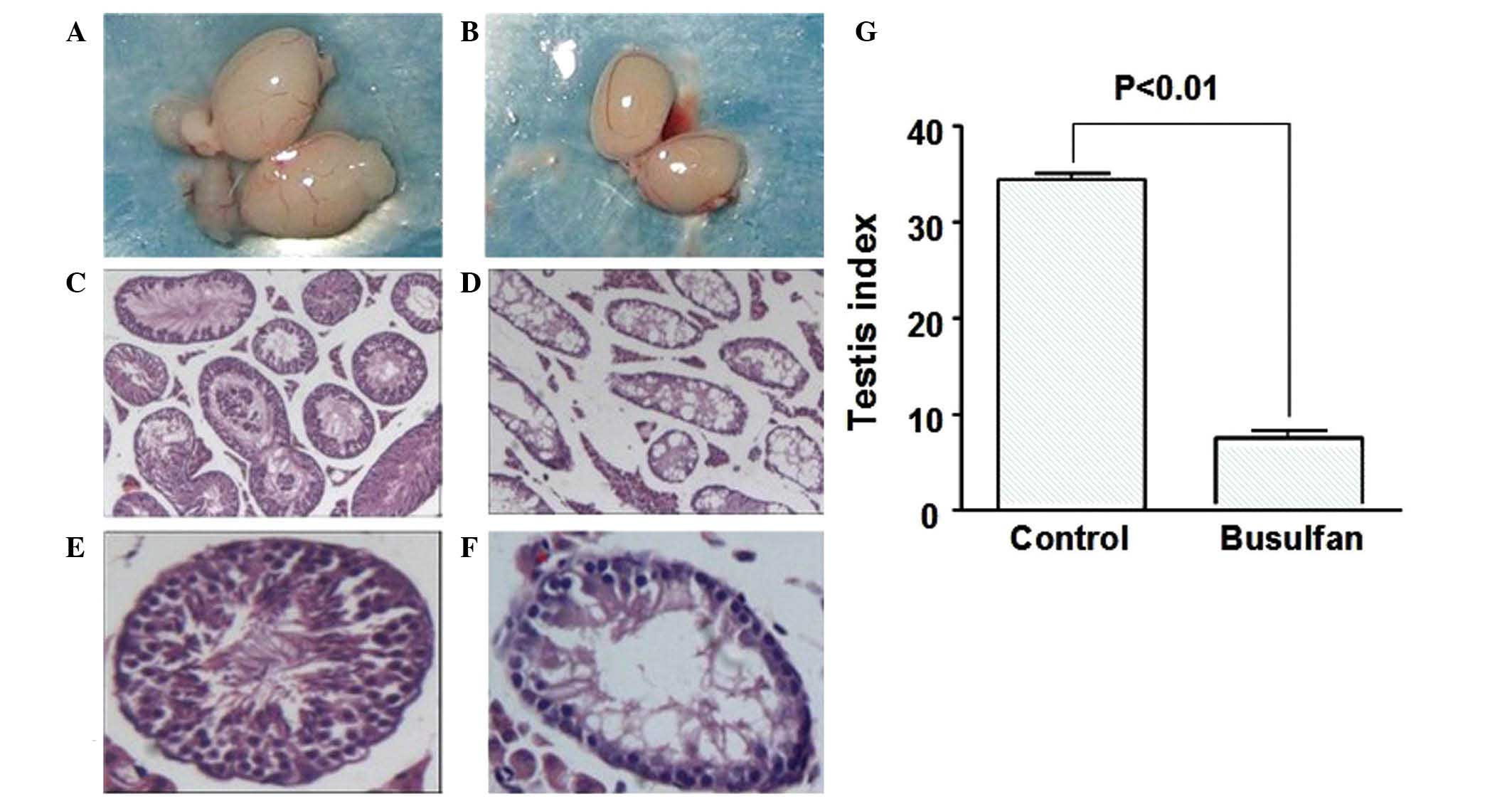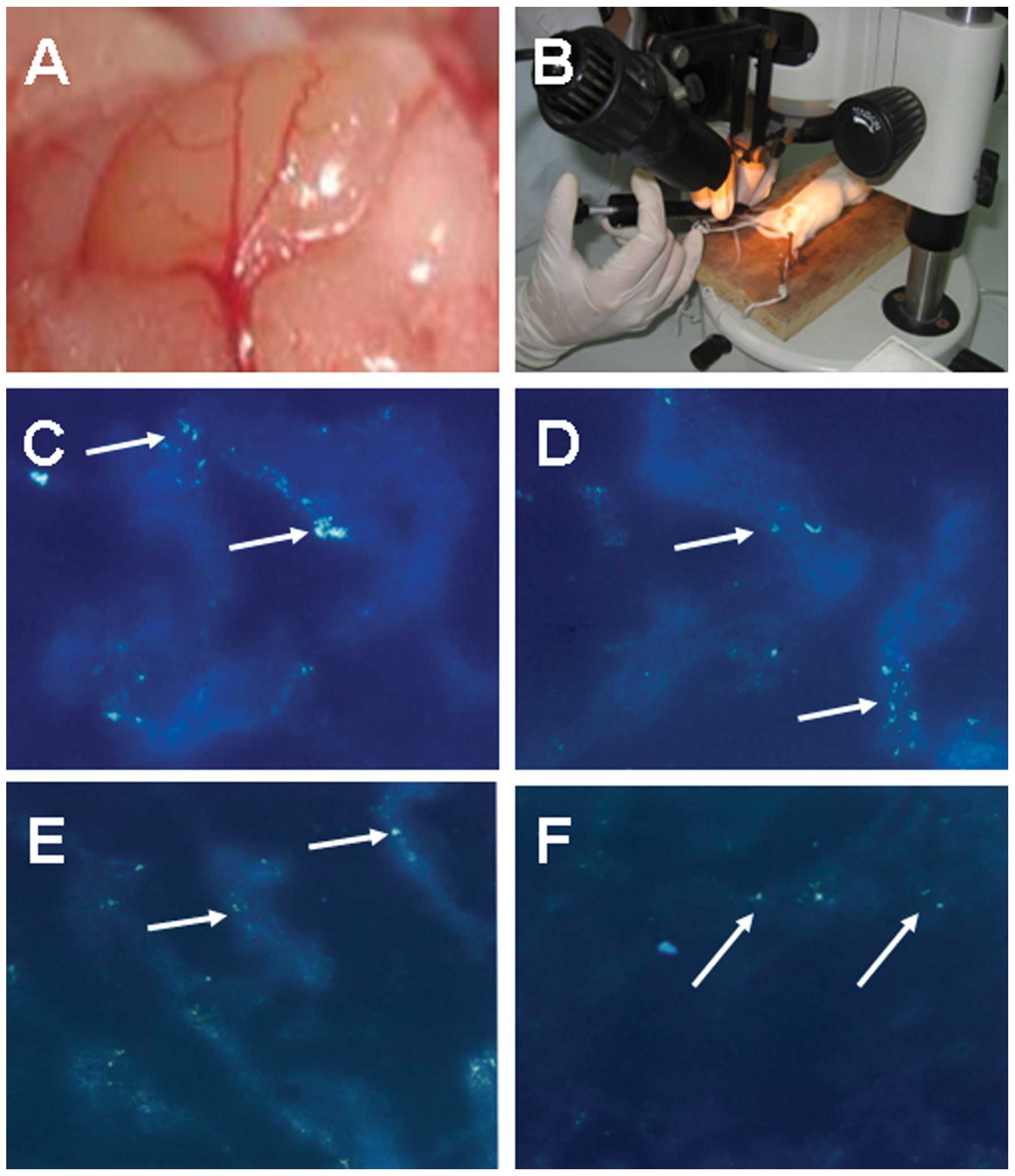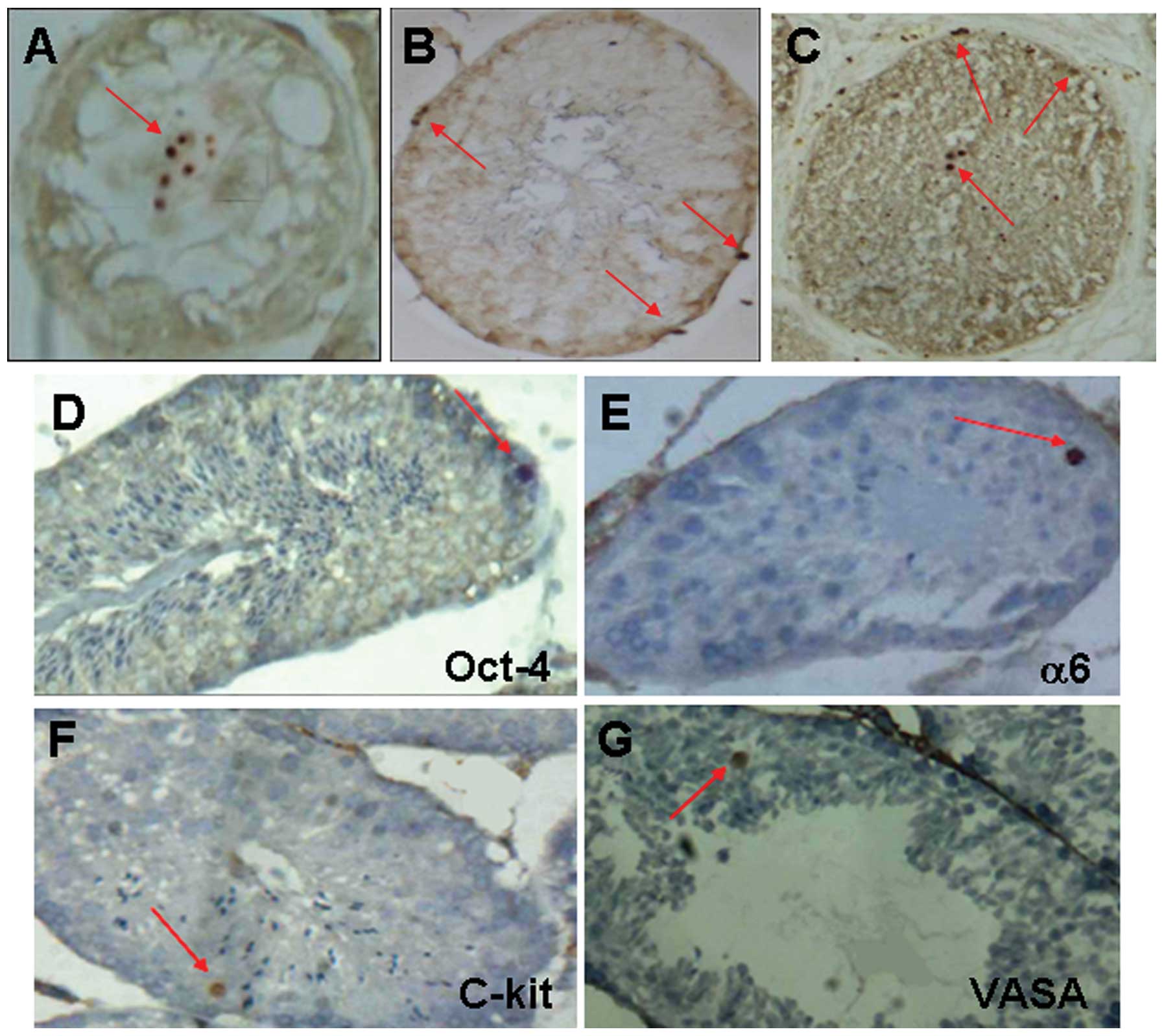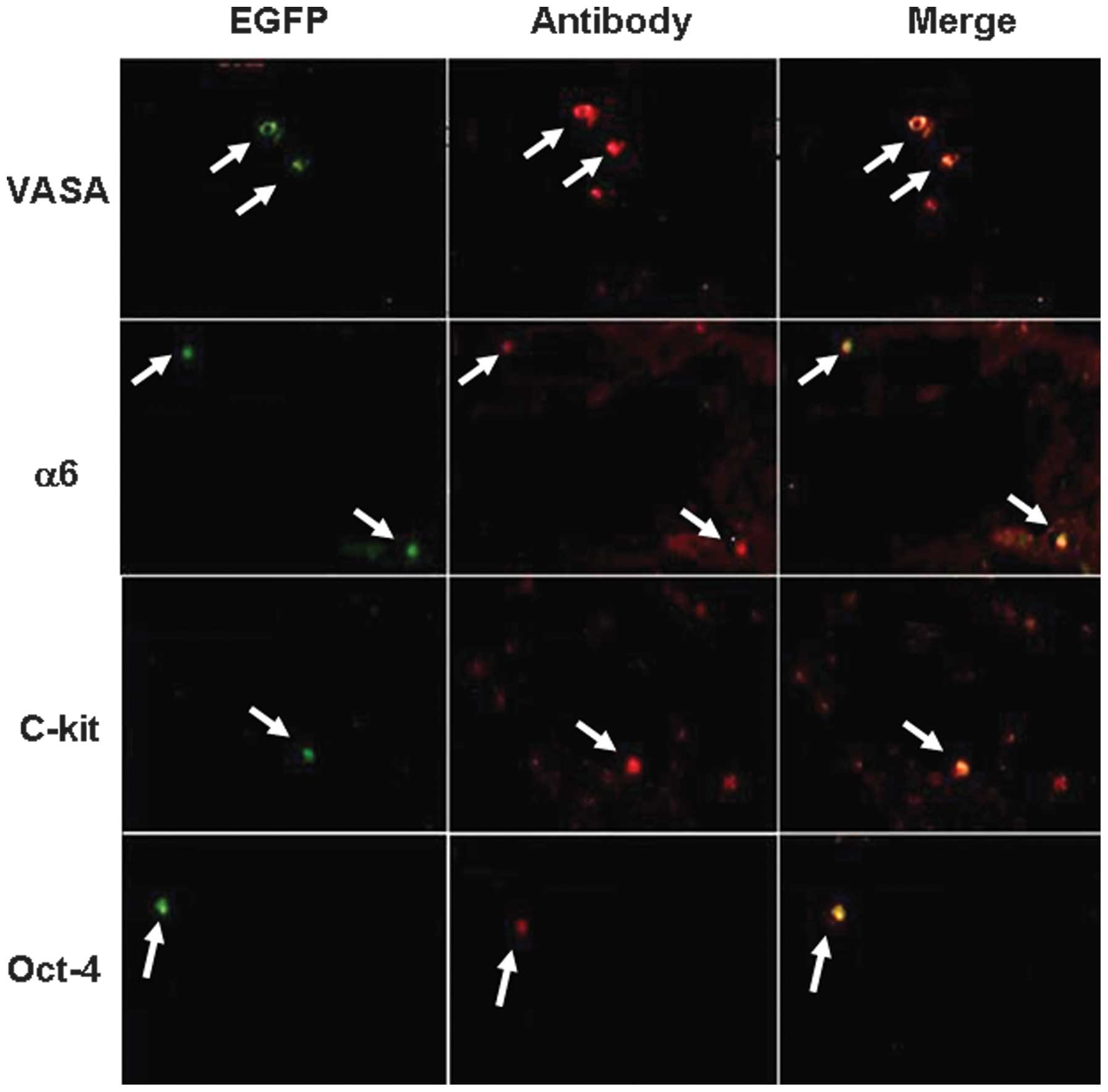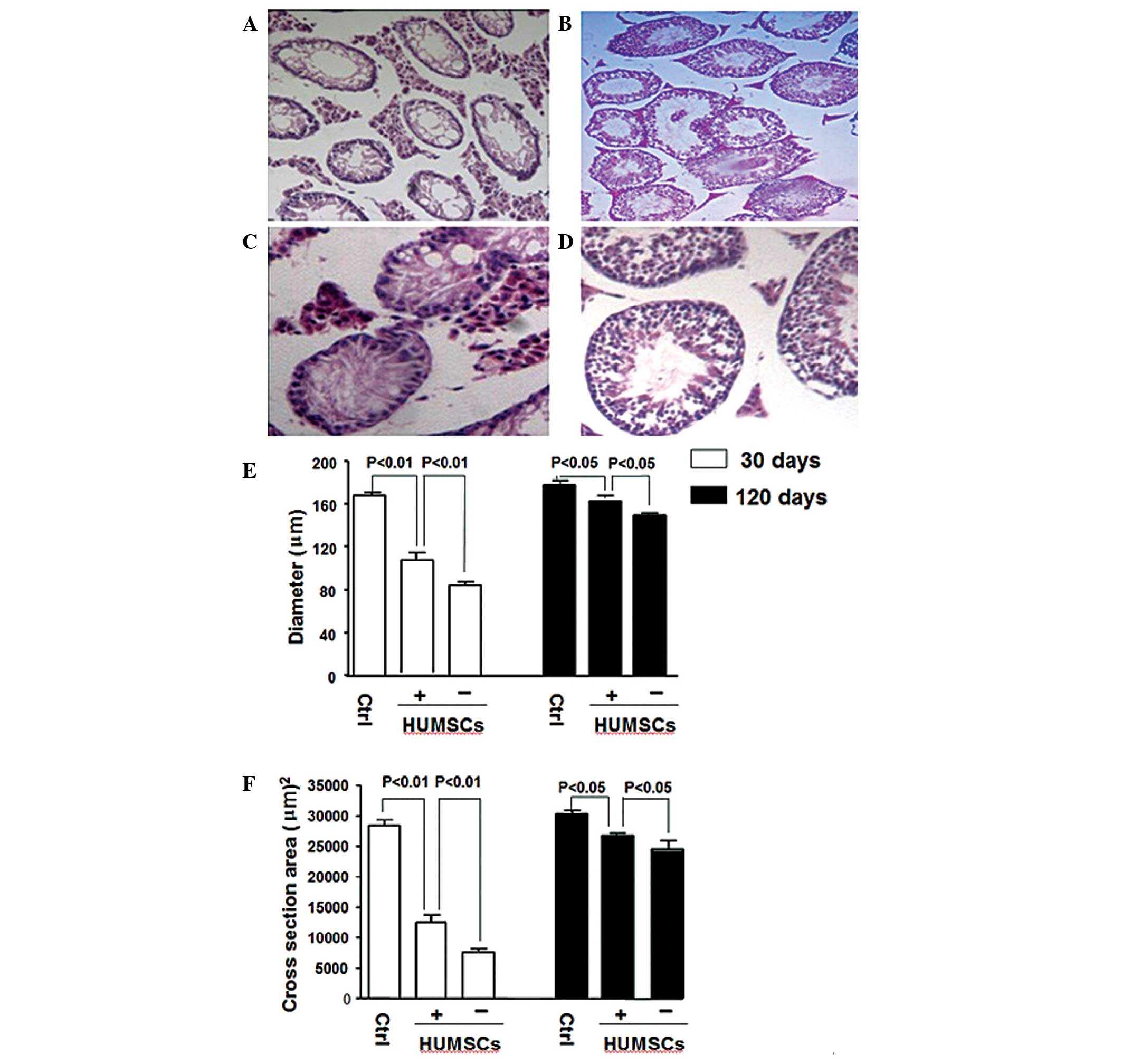Introduction
Infertility affects 15% of couples and half of this
is due to reproductive problems in males (1). The pathogenesis of male infertility
is due to the inability of germ cells to proliferate and
differentiate or somatic-cell dysfunction (2). Several cases of male infertility can
be treated by assisted reproductive techniques. However,
infertility due to azoospermia or sperm deformity has been a
challenge for reproductive medicine (3). In addition, cancer patients may
suffer from reproductive failure due to the adverse effect of
cancer therapeutics. Stem cell therapy has thus attracted
significant interest.
Previous studies have demonstrated that embryonic
stem cells (ESCs) (4–11), bone-marrow stem cells (BMSCs)
(12), induced pluripotent stem
cells (13) and stem cells derived
from fetal porcine skin or rat exocrine pancreas can be induced to
differentiate toward a germ-cell lineage in vitro (14,15).
Furthermore, transplanted mouse BMSCs have been demonstrated to
form germ cells in vivo (16). While studies using ESCs (4–11),
BMSCs (12) or other sources of
stem cells (13–15) have been instrumental in shedding
light onto the potential of germ cell differentiation, their
clinical applications may be limited due to ethical challenges or
difficulties in obtaining sufficient quantities. Thus, identifying
an ideal source of stem cells for use in infertility treatment is
being pursued.
Previous studies have indicated that human umbilical
cord mesenchymal stem cells (HUMSCs) are a novel source of
multipotent stem cells. These cells exhibit a fibroblast-like
morphology, express mesenchymal markers, possess pluripotent
characteristics for indefinite proliferation and are able to
differentiate into advanced derivatives of all three germ layers,
including osteocytes, chondrocytes, adipocytes, cardiomyocytes,
islet cells and neurons (17–21).
Several studies have also demonstrated that HUMSCs express low
levels of human leukocyte antigen (HLA)-ABC and do not express
HLA-DR (22,23), thus rendering them immunodeficient.
In addition, HUMSCs are immunosuppressive in mixed lymphocyte
assays (24). The low risk of host
rejection coupled with the large donor pool, rapid availability and
lack of ethical complications in use, renders HUMSCs a good cell
source for use in regenerative medicine.
Our previous study demonstrated that HUMSCs,
cultured in a testicular-cell-conditioned medium containing
retinoic acid and testosterone, underwent morphological changes and
expressed the germ-cell markers octamer-binding transcription
factor 4 (Oct-4; POUF5), α6 integrin (CD49f), Stella (DDPA3), C-kit
and VASA (DDX4) (25). The present
study aimed to investigate the differentiation potential of HUMSCs
in vivo by transplanting them into the seminiferous tubules
of mice treated with the chemotherapeutic busulfan. In addition,
the effect of HUMSCs in repairing the structural damage to the
testes caused by the cancer drug was examined.
Materials and methods
Isolation and expansion of HUMSCs
Isolation and expansion of HUMSCs was performed, as
previously described (25) and
methods for obtaining the human umbilical cord were approved by the
Institutional Review Board of Shantou University Medical College
(Shantou, China). Briefly, human umbilical cords were obtained from
patients providing written, informed consent and delivering
full-term male infants by cesarean section at the Second Affiliated
Hospital of Shantou University Medical College. Following removal
of the arteries and veins, the remaining tissue, Wharton’s jelly,
was transferred to a sterile container in high glucose Dulbecco’s
modified Eagle’s medium (H-DMEM; Gibco-BRL, Carlsbad, CA, USA) and
diced into small fragments. The explants were transferred into
24-well plates in fresh growth medium (H-DMEM containing 10% fetal
bovine serum, 100 mg/ml penicillin, 100 mg/ml streptomycin and 1
mg/ml amphotericin B) and left undisturbed for 5–7 days at 37°C in
a humidified incubator with 5% CO2 to allow migration of
cells from the explants, during which, the media was replaced every
2 days. When the cells reached 80–90% confluence, they were
harvested using a 0.05% trypsin/0.53 mM EDTA (Sigma-Aldrich, St.
Louis, MO, USA) solution and re-plated into larger culture flasks
at a 1:3 ratio.
Flow cytometry
HUMSCs at passage three were analyzed using flow
cytometry to examine the expression of pluripotent cell markers.
Following trypsinization, ~1×106 cells were pelleted,
resuspended in phosphate-buffered saline (PBS) and fixed with 4%
buffered paraformaldehyde (Gibco-BRL) for 20 min at room
temperature. Cells were then incubated with monoclonal mouse
anti-human antibodies against phycoerythrin (PE)-conjugated CD29
and CD59, or fluorescein isothiocyanate (FITC)-conjugated CD44 (BD
Biosciences, Franklin Lakes, NJ, USA). Cells were incubated in the
dark for 30 min at 4°C. In order to detect the presence of Oct-4,
the cells were permeabilized in PBS with 1% Triton X-100 for 10 min
at room temperature, fixed and incubated with a monoclonal mouse
anti-human antibody against Oct-4 (Santa Cruz Biotechnology, Inc.,
Santa Cruz, CA, USA) overnight at 4°C. Cells were then stained in
the dark with a PE-conjugated secondary antibody for 30 min at 4°C.
Control samples were incubated with FITC or PE-conjugated mouse
IgG1 isotype antibodies (Santa Cruz Biotechnology, Inc.). Following
incubation, the cells were washed with PBS, centrifuged at 200 × g
for 10 min to remove any unbound antibodies, resuspended in 1 ml
PBS and analyzed using EPICS XL flow cytometry (Beckman-Coulter
Inc., Miami, FL, USA).
Animal preparation
Male Kunming mice were purchased from the Laboratory
of Traditional Chinese Medicine, Guangzhou University (Guangzhou,
China). The animals were maintained under standard laboratory
conditions (12 h light/12 h dark). Mice at 4 weeks of age received
a single intraperitoneal injection of busulfan (Sigma-Aldrich) at
40 mg/kg to destroy endogenous spermatogenesis (26). All animal experimental methods were
approved by the Institutional Animal Care and Use Committee of
Shantou University Medical College.
Cell labeling and transplantation
Cultured HUMSCs at passage three were divided into
three groups, one stained with Hoechst 33258, a second labeled with
bromodeoxyuridine (BrdU) and the third transfected with
pIRES2-enhanced green fluorescence protein (EGFP; Clontech
Laboratories, Inc., Mountain View, CA, USA). Hoechst staining was
performed by incubating cells with Hoechst vital dye (bisbenzimide
H 33258; Sigma-Aldrich) in the growth medium at a concentration of
10 ng/ml for 90 min at 37°C. For BrdU labeling, BrdU
(Sigma-Aldrich) was added to the log-phase growing cells in the
growth medium at a concentration of 5 μg/ml and incubated
for 24 h prior to transplantation. Transfection of pIRES2-EGFP into
HUMSCs was performed using Lipofectamine™ 2000 (Invitrogen Life
Technologies, Carlsbad, CA, USA) according to the manufacturer’s
instructions. The transfection efficiency was assessed 48 h later
under a fluorescent microscope (DM 2500; Leica Camera AG, Solms,
Germany).
Cells labeled using the three methods were washed
and resuspended in DMEM. The cell concentration was adjusted to
5×106/ml and ~15 μl cell suspension
(2.5×105 cells) was micro-injected into the seminiferous
tubules of mice 4 weeks after busulfan administration. The
transplantation procedure was conducted using the method previously
described (27). Briefly, the mice
were anesthetized and placed in dorsal recumbence to expose the
testis. The cell suspension was then injected with a microinjector
(Karl Storz GmbH & Co, Tuttlingen, Germany) into three to four
sites of each testis under a stereomicroscope (Motic China Group,
Co., Ltd., Xiamen, China). Busulfan-treated testes without
transplantation and testes from normal mice were used as controls.
The host mice did not receive any immunosuppressive agent.
Immunohistochemistry and
immunofluorescence
Mice were sacrificed by cervical dislocation at 3,
9, 18 and 20 days, and the testes were dissected, decapsulated and
processed, as described below.
To visualize the Hoechst 33258 staining, testes were
frozen and cut into 5-μm sections. Frozen slides were
shielded from light, fixed in cold acetone for 10 min and
air-dried. Testicular sections were then observed under a
fluorescent microscope (Olympus BX60; Olympus, Tokyo, Japan) at a
wavelength of 346 nm.
For immunohistochemical analysis of the transplanted
HUMSCs, the testes were fixed with formaldehyde, embedded in
paraffin and cut into 5-μm sections. These were then
deparaffinized, rehydrated by successive series of ethanol and
rinsed in distilled water. Antigen retrieval was performed in 0.01
mol/l citric buffer (Shanghai Enzyme-linked Biotechnology Co., Ltd,
Shanghai, China) at pH 6.0 in a pressure oven, sections were then
washed with 0.1 mol/l PBS and incubated in 3%
H2O2 to quench endogenous peroxidase. This
was followed by washing with 0.1 mol/l PBS. Sections were blocked
with 5% bovine serum albumin for 20 min, incubated overnight at 4°C
with the monoclonal primary antibodies of goat anti-human VASA (12
μg/ml; R&D Systems, Minneapolis, MN, USA), mouse
anti-human α6 integrin (1:150; Abcam, Cambridge, UK), mouse
anti-human Oct-4 (1:60; Santa Cruz Biotechnology, Inc.), mouse
anti-human C-kit (1:70; Zhongshan Co., Beijing, China), at the same
time and mouse anti-BrdU (1:50; Wuhan Boster Biological Technology,
Ltd., Wuhan, China). Following washing to remove unbound primary
antibodies, the sections were incubated with monoclonal
biotinylated secondary antibodies of rabbit anti-goat IgGs or goat
anti-mouse IgGs (1:50; Wuhan Boster Biological Technology, Ltd.).
The avidin-biotinylated horseradish peroxidase complex was
visualized using 3,3′diaminobenzidine tetrahydrochloride (Wuhan
Boster Biological Technology, Ltd.). Slides were counterstained
with hematoxylin & eosin (H&E) and viewed under a
microscope (DM IRE2, Leica Camer AG). The testes from the
busulfan-treated mice without transplantation and from the normal
mice were processed identically to the negative controls.
For immunofluorescent analysis of colocalization of
EGFP with germ-cell markers expressed by transplanted HUMSCs,
testicular sections were processed immunohistochemically, as
described above, however, the secondary antibodies used were
Cy3-labeled rabbit anti-goat IgGs or Cy3-labeled sheep anti-mouse
IgGs (Sigma). Slides were washed and mounted in mounting medium and
viewed under a fluorescent confocal microscope (TCS SP5; Leica
Camera AG). The testes without transplantation were processed
identically to the negative controls.
Measurement of mean diameter and
cross-sectional area of seminiferous tubules
Testicular sections were processed for H&E
staining prior to measuring the mean diameter and cross-sectional
area of the seminiferous tubules using a high multiple image
analytical system (HMIAS-2000; Jinma Medical Instrument, Inc.,
Xian, China). The system randomly selects 10 areas in a testicular
section for measurement, from which mean values are automatically
generated. Eight testicular sections from each experimental group
were analyzed using this system.
Statistical analysis
SPSS version 13.0 software (SPSS, Inc., Chicago, IL,
USA) was used for statistical analyses. Data were analyzed using a
paired t-test. P<0.05 was considered to indicate a statistically
significant difference.
Results
Cellular characteristics of HUMSCs in
primary culture
A primary culture of HUMSCs was established by
growing tissue fragments of Wharton’s jelly from the human
umbilical cord in tissue culture plates. Tissues grew adherent to
the plate and, after 5–7 days culture, the HUMSCs started to
migrate out from the explant (Fig.
1A). The medium was replaced every 2 days until the cells
reached 90% confluence prior to passages. At passages one to nine,
the cells were fibroblast-like, appeared flat, spindle-shaped or
polygonal (Fig. 1B–D). They grew
with the doubling time of ~36 h and the growth rate gradually
decreased following nine passages. To determine whether HUMSCs had
multipotent potential, the cells at passage three were assessed for
the expression of markers associated with ESCs and adult stem cells
using flow cytometry. As shown in Fig.
1E, 46.3% of these cells were positive for the ESC marker Oct-4
and 87.0, 44.9 and 95.0% of the cells were positive for antigens
associated with pluripotent adult stem cells CD29, CD44 and CD59,
respectively. These data were consistent with our previous study
(25) and those of Wang et
al (28).
Preparation of germ-cell deficient
recipient mice
To investigate the germ-cell differentiation of
HUMSCs in vivo, the recipient mice were administered with 40
mg/kg busulfan to destroy endogenous spermatogenesis (26). Busulfan is the drug of choice to
treat myelogenous or granulocytic leukemia, which adversely affects
spermatogenesis in mammals (29).
It is used in transplantation studies as the treatment provides
access for transplanted cells to the basal compartment of tubules
and reduces the competition from endogenous germ cells (30). The testes of treated mice appeared
smaller than those of untreated testes 4 weeks after the drug
treatment (Fig. 2A and B).
Quantitative measurement of the mouse testicular index, a ratio of
testicular weight / body weight, was 6.5 in the drug-treated group
compared with 34.2 in the untreated group (Fig. 2G). Histologically, the seminiferous
tubules of treated mice appeared vacuolous (Fig. 2C) with only one layer of germ cells
remaining at the periphery (Fig.
2E). By contrast, the tubules of the untreated mice had
multiple layers of germ cells, with proliferating spermatogonia at
the basement, round spermatids and elongated spermatozoa close to
or within the lumen (Fig. 2F).
These busulfan-treated mice were then used for subsequent
studies.
Transplantation of HUMSCs into mouse
seminiferous tubules
In order to assess successful microinjection and
initially monitor the survival of HUMSCs in mouse seminiferous
tubules, HUMSCs at passage three were stained with Hoechst 33258
and ~2.5×105 cells were injected into the tubule of
busulfan-treated mice using a stereomicroscope. The testicular
sections were examined at various time points following
transplantation by fluorescent microscopy. At days three and nine
following transplantation, the HUMSCs were observed within the
contour of the seminiferous tubules, distributed predominantly in
clusters (Fig. 3C and D). By day
18, the cells appeared dispersed and spread to a wider range within
the tubule (Fig. 3E). The
fluorescence became weakened with time, nevertheless remained
detectable at day 20 (Fig. 3F).
The data indicated that microinjection of HUMSCs into seminiferous
tubules was amenable and that HUMSCs were able to survive for at
least 20 days in immunocompetent mouse testes. The weakened
fluorescence may have been due to the fluorescence decay of Hoechst
33258 and the possible proliferation or death of HUMSCs in
vivo.
Colonization and differentiation of
HUMSCs in mouse seminiferous tubules
To assess the long-term survival and colonization of
HUMSCs in the seminiferous tubules of busulfan-treated mice, HUMSCs
were labeled in vitro with BrdU prior to transplantation.
Colonization of HUMSCs was evaluated at 30, 60 and 120 days after
transplantation by immunohistochemistry using anti-BrdU antibodies.
At day 30, the majority of the HUMSCs remained in the luminal
compartment of the tubules, where the cells were injected (Fig. 4A). At day 60, the majority of cells
had migrated to the basement of the tubules (Fig. 4B) where proliferating spermatogonia
reside. At day 120, a number of cells had returned to the luminal
face where spermatids and spermatozoa reside, while others remained
at the basement of the tubules (Fig.
4C). This migration pattern resembled that of germ cell
development in vivo. During the process, the cells exhibited
a round shape (Fig. 4) typical of
proliferating/differentiating germ cells. The testes without
transplantation were negative for anti-BrdU staining. These data
indicated that the HUMSCs survived for at least 120 days in the
immunocompetent mouse testes and that the migration pattern and
morphology suggested the differentiation of HUMSCs into germ
cells.
To confirm the germ cell differentiation, expression
of the germ-cell markers Oct-4, α6 integrin, C-kit and VASA by the
transplanted HUMSCs was evaluated. α6 integrin is the surface
marker of spermatogonial stem cells (31). Oct-4 is enriched in proliferating
spermatogonia and downregulated upon differentiation (32–34).
VASA is specifically expressed in germ cells from the primordial to
the post-meiotic stage (32,35)
and C-kit is expressed by early spermatogenic cells, late
spermatocytes and spermatids (36,37).
In our previous study, these markers were expressed by HUMSCs when
induced to differentiate toward the germ-cell lineage in
vitro (25). Testicular
sections were obtained 120 days after transplantation and analyzed
using immunohistochemistry with human-specific antibodies against
the aforementioned antigens. As shown in Fig. 4D–G, immunopositive cells for these
markers were present, which appeared large and round. No
immunopositive cells were observed in the testes without HUMSC
transplantation. These findings confirmed the germ cell
differentiation of HUMSCs in mouse testes.
Colocalization of EGFP-positive HUMSCs
with cells expressing human germ-cell markers in mouse testes
To rule out any cross-reactivity of the antibodies
with mouse antigens, HUMSCs were transiently transfected with
EGFP-expressing vectors. The transfection efficiency was ~40% and
cells were microinjected 48 h post transfection into mouse
seminiferous tubules. Colocalization of EGFP-positive cells with
cells expressing the germ-cell markers Oct-4, α6 integrin, C-kit
and VASA was assessed by immunofluorescent microscopy using the
antibodies indicated in Fig. 4D–G.
As shown in Fig. 5, the
EGFP-positive cells were colocalized with the antibody-positive
cells (Fig. 5, Merge). The EGFP
signal became weakened with time, however, a similar colocalization
result was observed 120 days after transplantation (data not
shown). Notably, there were significantly more C-kit-positive cells
than EGFP-positive cells in the corresponding field (Fig. 5), implying the possible
proliferation of HUMSCs and an upregulation of C-kit. In addition,
there were very few Oct-4-positive cells (Fig. 5), which may suggest a
downregulation of Oct-4.
Histological features of mouse
seminiferous tubules transplanted with HUMSCs
During the present study, an improvement of
testicular histological features following HUMSC transplantation
was observed. At day 30 after transplantation, the tubules of
busulfan-treated mice had fewer vacuoles and more cells (Fig. 6B) than those of the untransplanted
tubules (Fig. 6A). At day 120, the
morphological improvement was more pronounced, where transplanted
tubules had markedly more germ cells forming a multi-layered cell
organization (Fig. 6D), while the
untransplanted tubules maintained a mono-layered cell structure
(Fig. 6C). The mean diameter and
cross-sectional area of the tubules were further analyzed
quantitatively using a high multiple image analytical system. At 30
days after transplantation, the mean tubule diameter was 114
μm in the transplantation group compared with 85 μm
in the untransplanted group (Fig.
6E), representing a 34% increase; the mean cross-sectional area
of tubules was 13,582 μm2 in the transplanted
group compared with 8,624 μm2 in the
untransplanted group (Fig. 6F),
representing a 58% improvement. The values between the two groups
were statistically different and were smaller than the age-matched
control mice that did not receive busulfan (mean diameter 168
μm and mean cross-sectional area 27,026
μm2). At day 120, the two groups demonstrated
further improvement in tubule diameter and cross-sectional area,
approaching those of the age-matched control mice (Fig. 6E and F). However, these parameters
remained improved in the transplantation group (Fig. 6E and F). These data indicated that
transplantation of HUMSCs facilitated the recovery of the tubule
morphology damaged by busulfan treatment.
Discussion
In the present study, the potential of multipotent
HUMSCs to differentiate into germ cells was examined by
transplanting them into the seminiferous tubules of mice treated
with busulfan. The results revealed that HUMSCs survived in the
mouse testis for at least 120 days, exhibited a round cell shape
typical of proliferating/differentiating germ cells, migrated in a
pattern resembling that of germ cell development in vivo and
expressed the germ-cell markers Oct-4, α6 integrin, C-kit and VASA.
The present study also demonstrated that the transplantation of
HUMSCs facilitated the structural recovery of the seminiferous
tubule damaged by busulfan, as judged by morphology and
quantitative histology.
During spermatogenesis in seminiferous tubules, germ
cells exist in three main developmental phases: mitosis, meiosis
and spermiogenesis. The three phases of germ cells are arranged in
a highly organized architecture with spermatogonial stem
cells/proliferating spermatogonia present at the basal lamina of
the tubule and the post-meiotic spermatids and mature spermatozoa
present close to or in the lumen (30). Proliferating or differentiating
germ cells exhibit a round cell shape, with the exception of the
characteristic appearance of mature spermatozoa (30). Using BrdU labeling to follow the
survival and colonization of transplanted HUMSCs in mouse
seminifierous tubules, the present study demonstrated that
transplanted HUMSCs migrated to the basal compartment, which was
followed by returning back towards the luminal compartment. During
the migration process, these cells were observed as single round
cells. The morphology and migration pattern of transplanted HUMSCs
are thus consistent with germ cell development in vivo.
Molecular markers are specifically expressed or
enriched during each stage of germ cell development.
Immunohistochemical and colocalization studies revealed that
transplanted HUMSCs expressed the germ-cell markers Oct-4, α6
integrin, C-kit and VASA 30 days after transplantation and the
expression remained at least 120 days after transplantation. In the
present study, Oct-4 was also found to be expressed by
undifferentiated HUMSCs. However, the expression of α6 integrin,
C-kit and VASA occurred only in the transplanted HUMSCs, thus
confirming germ-cell differentiation. Of these molecular markers,
Oct-4 is expressed by proliferating spermatogonia and downregulated
upon differentiation (32–34). C-kit has been demonstrated to be
expressed by all stages of germ cells (37), although a previous study indicated
that it is expressed only by late spermatocytes and round
spermatids (36). The observation
that there may be a downregulation of Oct-4 with a concomitant
upregulation of C-kit in HUMSC-derived germ cells may suggest that
these cells may have differentiated into late stages of germ cells.
Further studies to examine the expression of meiotic markers,
including SCP1 and SCP3 are required to confirm the progression
through the meiotic phase.
The present study demonstrated that HUMSCs survived
in immunocompetent mouse testes for at least 120 days. HUMSCs have
been demonstrated to have low immunogenicity (22,23),
as well as to possess immunosuppressive activities (24). Transplanting HUMSCs into the brain
of immunocompetent rats did not provoke a host immune rejection in
the xenogeneic background, with transplanted cells surviving for at
least 4 months (23). The present
study provides additional support for the low-risk of host
rejection and the potential long-term survival of HUMSCs in the
allogeneic background of clinical applications.
Busulfan is the drug of choice to treat myelogenous
or granulocytic leukemia, which adversely affects spermatogenesis
in mammals (29). High doses of
busulfan (40 mg/kg) eradicates germ cells, sterilizes mice and
results in long-term morphological damage to sperm produced by the
surviving spermatogonial stem cells (26). However, other studies have
demonstrated that spermatogenesis is able to partly recover
following two spermatic cycles (38). Notably, the present study
demonstrated a marked improvement in the histological features of
the tubules transplanted with HUMSCs, despite the relatively small
fraction of cells (2.5×105) injected into each testis.
This observation is of particular significance in the context of
the tubule damage caused by the gonadotoxic effect of busulfan and
may have far-reaching implications on HUMSCs in the treatment of
testicular insufficiency caused by cancer therapeutics.
HUMSCs have been demonstrated to have therapeutic
effects in pre-clinical animal models for neurodegenerative disease
(23), cancer (39,40)
and corneal disease (41). The
underlying mechanisms are postulated to be due to the release of
trophic factors and dampening of the host immune response to limit
secondary inflammatory damage. In the present study, no apparent
inflammatory infiltrates in the testes of busulfan-treated mice nor
mice transplanted with HUMSCs were observed. It is possible that
the trophic factors released by the HUMSCs may be one of the
underlying molecular mechanisms in testicular tissue repair. It is
also possible that HUMSC-derived germ cells and/or HUMSC-derived
Sortoli cells, which were not assessed in the present study but
warrant further investigation, may secrete trophic factors,
including bone morphogenetic protein 4, leukemia inhibitory factor,
stem cell factor and growth differentiation factor-9 that are
required for the development of germ cells in the testes (42–45).
Furthermore, mechanistic studies, as well as assessment of mouse
fertility, are required to extend the initial observation of HUMSCs
in testicular tissue repair.
In conclusion, the present study demonstrated that
HUMSCs transplanted into the testes of immnuocompetent mice
survived long-term, differentiated into germ cells and facilitated
the restoration of tubule morphology that was damaged by the
chemotherapeutic busulfan. These data demonstrated the capacity of
HUMSCs to form germ cells in the testes and to repair the
testicular tissue. These findings, together with the low-risk of
host rejection, abundant source and lack of ethical complications
in use, suggest the potential utility of HUMSCs to treat
infertility and testicular insufficiency caused by cancer
therapeutics.
Acknowledgments
The present study was supported by the National
Natural Science Foundation of China (grant nos. 31040057 and
81070478), the Natural Science Foundation of Guangdong Province,
China (grant no. 10151503102000033) and the Science and Technology
Planning Project of Guangdong Province, China (grant no.
2013B022000021). The authors would like to thank Mr. Qing-Dong Xie
for his technical support.
References
|
1
|
Kleiman SE, Yogev L, Gamzu R, Hauser R,
Botchan A, Lessing JB, Paz G and Yavetz H: Genetic evaluation of
infertile men. Hum Reprod. 14:33–38. 1999. View Article : Google Scholar : PubMed/NCBI
|
|
2
|
O’Flynn O’Brien KL, Varghese AC and
Agarwal A: The genetic causes of male factor infertility: a review.
Fertil Steril. 93:1–12. 2010. View Article : Google Scholar
|
|
3
|
Larson KL, DeJonge CJ, Barnes AM, Jost LK
and Evenson DP: Sperm chromatin structure assay parameters as
predictors of failed pregnancy following assisted reproductive
techniques. Hum Reprod. 15:1717–1722. 2000. View Article : Google Scholar : PubMed/NCBI
|
|
4
|
Bucay N, Yebra M, Cirulli V, Afrikanova I,
Kaido T, Hayek A and Montgomery AM: A novel approach for the
derivation of putative primordial germ cells and sertoli cells from
human embryonic stem cells. Stem Cells. 27:68–77. 2009. View Article : Google Scholar
|
|
5
|
Clark AT, Bodnar MS, Fox M, Rodriquez RT,
Abeyta MJ, Firpo MT and Pera RA: Spontaneous differentiation of
germ cells from human embryonic stem cells in vitro. Hum Mol Genet.
13:727–739. 2004. View Article : Google Scholar : PubMed/NCBI
|
|
6
|
Geijsen N, Horoschak M, Kim K, Gribnau J,
Eggan K and Daley GQ: Derivation of embryonic germ cells and male
gametes from embryonic stem cells. Nature. 427:148–154. 2004.
View Article : Google Scholar
|
|
7
|
Kee K, Gonsalves JM, Clark AT and Pera RA:
Bone morphogenetic proteins induce germ cell differentiation from
human embryonic stem cells. Stem Cells Dev. 15:831–837. 2006.
View Article : Google Scholar
|
|
8
|
Kerkis A, Fonseca SA, Serafim RC,
Lavagnolli TM, Abdelmassih S, Abdelmassih R and Kerkis I: In vitro
differentiation of male mouse embryonic stem cells into both
presumptive sperm cells and oocytes. Cloning Stem Cells. 9:535–548.
2007. View Article : Google Scholar : PubMed/NCBI
|
|
9
|
Nayernia K, Nolte J, Michelmann HW, Lee
JH, Rathsack K, Drusenheimer N, Dev A, Wulf G, Ehrmann IE, Elliott
DJ, Okpanyi V, Zechner U, Haaf T, Meinhardt A and Engel W: In
vitro-differentiated embryonic stem cells give rise to male gametes
that can generate offspring mice. Dev Cell. 11:125–132. 2006.
View Article : Google Scholar : PubMed/NCBI
|
|
10
|
Tilgner K, Atkinson SP, Golebiewska A,
Stojkovic M, Lako M and Armstrong L: Isolation of primordial germ
cells from differentiating human embryonic stem cells. Stem Cells.
26:3075–3085. 2008. View Article : Google Scholar : PubMed/NCBI
|
|
11
|
Toyooka Y, Tsunekawa N, Akasu R and Noce
T: Embryonic stem cells can form germ cells in vitro. Proc Natl
Acad Sci USA. 100:11457–11462. 2003. View Article : Google Scholar : PubMed/NCBI
|
|
12
|
Nayernia K, Lee JH, Drusenheimer N, Nolte
J, Wulf G, Dressel R, Gromoll J and Engel W: Derivation of male
germ cells from bone marrow stem cells. Lab Invest. 86:654–663.
2006. View Article : Google Scholar : PubMed/NCBI
|
|
13
|
Yang S, Bo J, Hu H, Guo X, Tian R, Sun C,
Zhu Y, Li P, Liu P, Zou S, Huang Y and Li Z: Derivation of male
germ cells from induced pluripotent stem cells in vitro and in
reconstituted seminiferous tubules. Cell Prolif. 45:91–100. 2012.
View Article : Google Scholar : PubMed/NCBI
|
|
14
|
Danner S, Kajahn J, Geismann C, Klink E
and Kruse C: Derivation of oocyte-like cells from a clonal
pancreatic stem cell line. Mol Hum Reprod. 13:11–20. 2007.
View Article : Google Scholar
|
|
15
|
Dyce PW, Wen L and Li J: In vitro germline
potential of stem cells derived from fetal porcine skin. Nat Cell
Biol. 8:384–390. 2006. View
Article : Google Scholar : PubMed/NCBI
|
|
16
|
Lue Y, Erkkila K, Liu PY, Ma K, Wang C,
Hikim AS and Swerdloff RS: Fate of bone marrow stem cells
transplanted into the testis: potential implication for men with
testicular failure. Am J Pathol. 170:899–908. 2007. View Article : Google Scholar : PubMed/NCBI
|
|
17
|
Chao KC, Chao KF, Fu YS and Liu SH:
Islet-like clusters derived from mesenchymal stem cells in
Wharton’s Jelly of the human umbilical cord for transplantation to
control type 1 diabetes. PLoS One. 3:e14512008. View Article : Google Scholar
|
|
18
|
Karahuseyinoglu S, Cinar O, Kilic E, Kara
F, Akay GG, Demiralp DO, Tukun A, Uckan D and Can A: Biology of
stem cells in human umbilical cord stroma: in situ and in vitro
surveys. Stem Cells. 25:319–331. 2007. View Article : Google Scholar
|
|
19
|
Karahuseyinoglu S, Kocaefe C, Balci D,
Erdemli E and Can A: Functional structure of adipocytes
differentiated from human umbilical cord stroma-derived stem cells.
Stem Cells. 26:682–691. 2008. View Article : Google Scholar : PubMed/NCBI
|
|
20
|
Mitchell KE, Weiss ML, Mitchell BM, Martin
P, Davis D, Morales L, Helwig B, Beerenstrauch M, Abou-Easa K,
Hildreth T, Troyer D and Medicetty S: Matrix cells from Wharton’s
jelly form neurons and glia. Stem Cells. 21:50–60. 2003. View Article : Google Scholar
|
|
21
|
Pereira WC, Khushnooma I, Madkaikar M and
Ghosh K: Reproducible methodology for the isolation of mesenchymal
stem cells from human umbilical cord and its potential for
cardiomyocyte generation. J Tissue Eng Regen Med. 2:394–399. 2008.
View Article : Google Scholar : PubMed/NCBI
|
|
22
|
Lu LL, Liu YJ, Yang SG, Zhao QJ, Wang X,
Gong W, Han ZB, Xu ZS, Lu YX, Liu D, Chen ZZ and Han ZC: Isolation
and characterization of human umbilical cord mesenchymal stem cells
with hematopoiesis-supportive function and other potentials.
Haematologica. 91:1017–1026. 2006.PubMed/NCBI
|
|
23
|
Weiss ML, Medicetty S, Bledsoe AR,
Rachakatla RS, Choi M, Merchav S, Luo Y, Rao MS, Velagaleti G and
Troyer D: Human umbilical cord matrix stem cells: preliminary
characterization and effect of transplantation in a rodent model of
Parkinson’s disease. Stem Cells. 24:781–792. 2006. View Article : Google Scholar
|
|
24
|
Weiss ML, Anderson C, Medicetty S,
Seshareddy KB, Weiss RJ, VanderWerff I, Troyer D and McIntosh KR:
Immune properties of human umbilical cord Wharton’s jelly-derived
cells. Stem Cells. 26:2865–2874. 2008. View Article : Google Scholar : PubMed/NCBI
|
|
25
|
Huang P, Lin LM, Wu XY, Tang QL, Feng XY,
Lin GY, Lin X, Wang HW, Huang TH and Ma L: Differentiation of human
umbilical cord Wharton’s jelly-derived mesenchymal stem cells into
germ-like cells in vitro. J Cell Biochem. 109:747–754.
2010.PubMed/NCBI
|
|
26
|
Bucci LR and Meistrich ML: Effects of
busulfan on murine spermatogenesis: cytotoxicity, sterility, sperm
abnormalities, and dominant lethal mutations. Mutat Res.
176:259–268. 1987. View Article : Google Scholar : PubMed/NCBI
|
|
27
|
Brinster RL and Avarbock MR: Germline
transmission of donor haplotype following spermatogonial
transplantation. Proc Natl Acad Sci USA. 91:11303–11307. 1994.
View Article : Google Scholar : PubMed/NCBI
|
|
28
|
Wang L, Ott L, Seshareddy K, Weiss ML and
Detamore MS: Musculoskeletal tissue engineering with human
umbilical cord mesenchymal stromal cells. Regen Med. 6:95–109.
2011. View Article : Google Scholar :
|
|
29
|
von Bubnoff N and Duyster J: Chronic
myelogenous leukemia: treatment and monitoring. Dtsch Arztebl Int.
107:114–121. 2010.PubMed/NCBI
|
|
30
|
Ogawa T, Aréchaga JM, Avarbock MR and
Brinster RL: Transplantation of testis germinal cells into mouse
seminiferous tubules. Int J Dev Biol. 41:111–122. 1997.PubMed/NCBI
|
|
31
|
Shinohara T, Avarbock MR and Brinster RL:
beta1- and alpha6-integrin are surface markers on mouse
spermatogonial stem cells. Proc Natl Acad Sci USA. 96:5504–5509.
1999. View Article : Google Scholar : PubMed/NCBI
|
|
32
|
Anderson RA, Fulton N, Cowan G, Coutts S
and Saunders PT: Conserved and divergent patterns of expression of
DAZL, VASA and OCT4 in the germ cells of the human fetal ovary and
testis. BMC Dev Biol. 7:1362007. View Article : Google Scholar : PubMed/NCBI
|
|
33
|
Dann CT, Alvarado AL, Molyneux LA, Denard
BS, Garbers DL and Porteus MH: Spermatogonial stem cell
self-renewal requires OCT4, a factor downregulated during retinoic
acid-induced differentiation. Stem Cells. 26:2928–2937. 2008.
View Article : Google Scholar : PubMed/NCBI
|
|
34
|
Rajpert-De Meyts E, Hanstein R, Jørgensen
N, Graem N, Vogt PH and Skakkebaek NE: Developmental expression of
POU5F1 (OCT-3/4) in normal and dysgenetic human gonads. Hum Reprod.
19:1338–1344. 2004. View Article : Google Scholar : PubMed/NCBI
|
|
35
|
Castrillon DH, Quade BJ, Wang TY, Quigley
C and Crum CP: The human VASA gene is specifically expressed in the
germ cell lineage. Proc Natl Acad Sci USA. 97:9585–9590. 2000.
View Article : Google Scholar : PubMed/NCBI
|
|
36
|
He Z, Kokkinaki M, Jiang J, Dobrinski I
and Dym M: Isolation, characterization, and culture of human
spermatogonia. Biol Reprod. 82:363–372. 2010. View Article : Google Scholar :
|
|
37
|
Sandlow JI, Feng HL and Sandra A:
Localization and expression of the c-kit receptor protein in human
and rodent testis and sperm. Urology. 49:494–500. 1997. View Article : Google Scholar : PubMed/NCBI
|
|
38
|
Ehmcke J, Joshi B, Hergenrother SD and
Schlatt S: Aging does not affect spermatogenic recovery after
experimentally induced injury in mice. Reproduction. 133:75–83.
2007. View Article : Google Scholar : PubMed/NCBI
|
|
39
|
Matsuzuka T, Rachakatla RS, Doi C, Maurya
DK, Ohta N, Kawabata A, Pyle MM, Pickel L, Reischman J, Marini F,
Troyer D and Tamura M: Human umbilical cord matrix-derived stem
cells expressing interferon-beta gene significantly attenuate
bronchioloalveolar carcinoma xenografts in SCID mice. Lung Cancer.
70:28–36. 2010. View Article : Google Scholar : PubMed/NCBI
|
|
40
|
Studeny M, Marini FC, Dembinski JL,
Zompetta C, Cabreira-Hansen M, Bekele BN, Champlin RE and Andreeff
M: Mesenchymal stem cells: potential precursors for tumor stroma
and targeted-delivery vehicles for anticancer agents. J Natl Cancer
Inst. 96:1593–1603. 2004. View Article : Google Scholar : PubMed/NCBI
|
|
41
|
Liu H, Zhang J, Liu CY, Wang IJ, Sieber M,
Chang J, Jester JV and Kao WW: Cell therapy of congenital corneal
diseases with umbilical mesenchymal stem cells: lumican null mice.
PLoS One. 5:e107072010. View Article : Google Scholar : PubMed/NCBI
|
|
42
|
Creemers LB, den Ouden K, van Pelt AM and
de Rooij DG: Maintenance of adult mouse type A spermatogonia in
vitro: influence of serum and growth factors and comparison with
prepubertal spermatogonial cell culture. Reproduction. 124:791–799.
2002. View Article : Google Scholar
|
|
43
|
Huleihel M and Lunenfeld E: Regulation of
spermatogenesis by paracrine/autocrine testicular factors. Asian J
Androl. 6:259–268. 2004.PubMed/NCBI
|
|
44
|
Pellegrini M, Grimaldi P, Rossi P, Geremia
R and Dolci S: Developmental expression of BMP4/ALK3/SMAD5
signaling pathway in the mouse testis: a potential role of BMP4 in
spermatogonia differentiation. J Cell Sci. 116:3363–3372. 2003.
View Article : Google Scholar : PubMed/NCBI
|
|
45
|
Takabayashi S, Sasaoka Y, Yamashita M,
Tokumoto T, Ishikawa K and Noguchi M: Novel growth factor
supporting survival of murine primordial germ cells: evidence from
conditioned medium of ter fetal gonadal somatic cells. Mol Reprod.
60:384–396. 2001. View Article : Google Scholar
|















